
Atheist anti-theist Jonathan M. S. Pearce is the main writer on the blog, A Tippling Philosopher. His “About” page states: “Pearce is a philosopher, author, blogger, public speaker and teacher from Hampshire in the UK. He specialises in philosophy of religion, but likes to turn his hand to science, psychology, politics and anything involved in investigating reality.” His words will be in blue.
*****
I am responding to portions of Pearce’s article, “Ruddy Flood Thing Again. And Armstrong.” (7-3-21). I recently explained the nature and widespread use of chiasmus. Readers will want to at least briefly peruse the main points of that because this paper will presuppose that knowledge (it’s new to me, too, having just discovered this aspect).
Here I will simply note the occurrence over and over of chiasmus in texts that are being blasted by Pearce’s atheist or skeptical (or — probably largely — theologically liberal) sources. He refers to The Oxford Handbook of the Pentateuch (edited by
Pearce cites Baruch Schwartz, one of the contributors, opining — we see the lead that Pearce has been following and parroting — about repetition in Genesis and Exodus (that he assumes is the result of multiple authors):
In all these cases and innumerable others, the individual passages provide no recognition that the event itself has already transpired or that it might not be the only such event. Every such narrative, and every similarly duplicated subsection of a repetitive narrative text, presents itself as the one and only account of the event described, as does its counterpart.
Dr. Schwartz is a highly credentialed scholar, yet he doesn’t seem to be aware of chiasmus at all, which is a bit of a puzzle. Let’s analyze his comments (cited by Pearce) about some of these “repetitive” texts in Genesis and Exodus:
we read twice that Yahweh informed Noah of his decision (6:17 and 7:4); . . .
Yes, because it’s part of a chiasm. In Wenham’s construction, see D (Gen 6:17) and H (7:45), which are coupled in the
literary “pyramid” with H’ (8:12-13) and D’ (9:11-17). Gordon Wenham is quite a biblical scholar, too.
twice we learn that he conveyed his instructions to Noah (6:18–21 and 7:1–3) . . .
Yes, because it’s part of a chiasm. In Wenham’s construction, see E+F and G, which are parallel to G’ (8:15-17), F’ (9:1-4), and E’ (9:8-10).
Yahweh twice mentions that he has seen the affliction of his people and has decided to act (3:7–8 and 3:9) . . .
Yes, because it’s part of a chiasm related to Exodus 3:1 to 4:5; see B and E, which are parallel to E’ (3:16-17a) and B’ (3:18-22).
Moses twice expresses his objections to having the task imposed upon him (3:11, 13 and 4:1, 10, 13); twice Yahweh responds to his reservations (3:12, 14–15 and 4:2–9, 11–12, 14–16), and so forth.
Yes, because it’s part of the same chiasm (Exodus 3:1 to 4:5) — do we detect a pattern by now? — ; see E (3:11), H (3:13c), and A’ (4:1) with E (3:12), I + J + I’ + H’ + G’ (3:14), F’ (3:15), and A’ (4:2-4).
Pearce then cites Professor of Old Testament Jakob Wohrle from the same volume. His citation will be fun for our present purposes, because he separates the text according to two supposed writers: “priestly” and “non-priestly.” Thus, if we show that a chiasm incorporates portions from both, then I submit that the supposition of it being composed by one writer becomes stronger.
his command to enter the ark (6:18b–21 [P]; 7:1–3 [non-P]), . . .
Schwartz mentioned the same couplet above, and I showed how it is part of a grand chiasm in Genesis, laid out by Wenham.
Even more clear is the chiastic structure of Genesis 6-9. Pearce cites Wohrle’s chapter in the 2016 book, The Formation of the Pentateuch:
Within the primeval history it is possible to reconstruct two parallel flood stories (Gen 6–9), a completely preserved Priestly version and a nearly completely preserved non-Priestly version.
Everyone’s entitled to their scholarly opinions. Wohrle thinks that the text wildly jumps back and forth between the “priestly” and “non-priestly” writers: as Pearce’s previous citation from him testifies in abundance. Those of us who are skeptical of DH think there is another, more plausible explanation for “two parallel flood stories”: a deliberate application of chiasmus by one writer, to help readers master and memorize the text (which may have also been — in terms of final formulation — oral for some time before it was written down). Thus, one can see the structure of this in Wenham’s 1978 hypothesis, and simpler versions by Anderson (also 1978) and Bullinger (1922). There is also a chiasm based on the observations of all three of the foregoing.
The same applies in the book of Exodus for the stories of the plagues (Exod 7–12) . . .
Again, the repetition is adequately accounted for by at least six chiasms (rather than multiple authors). See how they work for the following portions of Holy Scripture
and the crossing of the sea (Exod 14).
See the three chiasms involved there:
Remarkably, in these parts of the Pentateuch even the smallest narrative details are preserved twice.
It’s not “remarkable”; it’s simply chiasmus, or one of the many other sorts of biblical repetition. As I noted last time, Bible scholar E. W. Bullinger catalogued “over 200 distinct figures [in the Bible], several of them with from 30 to 40 varieties” in his 1104-page volume, Figures of Speech Used in the Bible (London: 1898; see the online complete book link too, and the paginated Internet Archive version).
He devotes 31 wonderful pages to a slightly larger category of literary devices (in relation to chiasmus) that he calls “Correspondence” (pp. 363-393). In addition to that, he also devotes a remarkable 202 pages (pp. 171-262, 294-403) to 44 more forms of deliberate literary repetition (with massive biblical examples provided, as always). I list them, to give readers an idea of the extraordinary research involved in compiling all of this (all linked in the page numbers):
Homoeopropheron; or Alliteration: The Repetition of the same Letter or Syllable at the commencement of Successive Words (pp. 171-175)
Homoeoteleuton; or Like Endings: The Repetition of the same Letters or Syllables at the end of Successive Words (p. 176)
Homoeoptoton; or Like Inflections: The Repetition of Inflections (p. 177)
Paromoeosis; or Like-Sounding Inflections: The Repetition of Inflections similar in Sound (pp. 178-179)
Acrostichion; or Acrostic: Repetition of the same or successive Letters at the beginnings of Words or Clauses (pp. 180-188)
Epizeuxis; or Duplication: The Repetition of the Same Word in the Same Sense (pp. 189-198)
Anaphora; or Like Sentence-Beginnings: The Repetition of the same Word at the beginning of successive Sentences (pp. 199-205)
Epanalepsis; or Resumption: The Repetition of the same word after a break, or parenthesis (pp. 206-207)
Polysyndeton; or Many-Ands: The repetition of the word “and” at the beginning of successive clauses (pp. 208-237)
Paradiastole; or Neithers and Nors: The Repetition of the Disjunctives Neither and Nor, or, Either and Or (pp. 238-240)
Epistrophe; or Like Sentence-Endings: The Repetition of the same Word or Words at the end of successive Sentences (pp. 241-243)
Epiphoza; or Epistrophe in Argument: The Repetition of the same Word or Words at the end of successive Sentences: used in Argument (p. 244)
Epanadiplosis; or Encircling: The Repetition of the same Word or Words at the beginning and end of a Sentence (pp. 245-249)
Epadiplosis; or Double Encircling: Repeated Epanadiplosis (p. 250)
Anadiplosis; or Like Sentence Endings and Beginnings: The Repetition of the same Word or Words at the end of one Sentence and at the beginning of another (pp. 251-255)
Climax: or Gradation: Repeated Anadiplosis (pp. 256-259)
[omitted three short sections]
Repetitio; or Repetition: Repetition of the same Word or Words irregularly in the same Passage (pp. 263-266)
Polyptoton; or Many Inflections: The Repetition of the same Part of Speech in different Inflections (pp. 267-285)
Antanaclasis: or Word-Clashing: Repetition of the same Word in the same Sentence, with Different Meanings (pp. 286-293)
[omitted two sections]
Symploce; or Intertwining: The Repetition of different Words in successive Sentences in the same Order and the same Sense (pp. 297-298)
Epanodos; or Inversion: The Repetition of the same Words in an inverse Order (but same Sense) (pp. 299-300)
Antimetabole; or Counterchange: Epanodos, with Contrast or Opposition (pp. 301-303)
Paregmenon; or Derivation: The Repetition of Words derived from the same Root (pp. 304-306)
Paronomasia; or Rhyming-Words: The Repetition of Words similar in Sound, but not necessarily in Sense (pp. 307-320)
Parechesis; or Foreign Paronomasia: The Repetition of Words similar in Sound, but different in Language (pp. 321-323)
Synonymia; or Synonymous Words: The Repetition of Words similar in Sense, but different in Sound and Origin (pp. 324-338)
Repeated Negation; or Many Noes: The Repetition of divers Negatives (pp. 339-341)
[omitted five short sections]
Parallelism; or Parallel Lines: The Repetition of similar, synonymous, or opposite Thoughts or Words in parallel or successive Lines (pp. 349-362)
Prosapodosis; or Detailing: A Returning for Repetition and Explanation (pp. 394-396)
[omitted two sections]
Exergasia: or Working Out: A Repetition, so as to work out or illustrate what has already been said (pp. 399-400)
[omitted two sections]
So here we are with 45 forms of biblical repetition: deliberately employed as literary technique: so complex that it takes 233 pages in a book to describe them and provide many biblical examples. But Pearce thinks the “only” reasonable, plausible explanation of such repetition is multiple authors and the Documentary Hypothesis:
The Pentateuch contains some irreconcilable issues that fall into four categories: repetition (redundancy), contradictions, discontinuity, terminology and style. The basic principle is that these four issues demand an explanation. The only thing that makes sense of this is that there are multiple sources (over multiple time periods) that have been redacted to produce the finished document. (7-2-21)
Pearce continues citing Jakob Wohrle:
To give just one more example, within the story about the crossing of the sea in Exod 14, the notice that the waters of the sea came back appears twice:
Exodus 14:27 (P) [. . .] The sea returned to its bed when the morning appeared [. . .]
Exodus 14:28 (non-P) The waters of the sea returned [. . .]Such doublets of the smallest details strongly speak against the assumption that the Priestly passages can be understood as a redactional layer. There is no plausible explanation for why a Priestly redactor should have added to the flood story a second request to enter the ark or why he should have added to the story about the crossing of the sea a second notice about the returning waters.
And this is another example of a chiasm, involving Exodus 14:21-31. Once one sees the two passages in the overall structure, it makes perfect sense, since it’s a technique used hundreds of times in the Old Testament.
Pearce likes Oxford Handbooks. He accepts their scholarship. Very well, then, The Oxford Handbook of the Writings of the Hebrew Bible (2018) mentions the concept of chiasmus 13 times, as can be found on a page for it, by searching “chias”. They appear on pages 120 [2], 129, 135 [2], 144, 291 [2], 292 [3], and 427 [2].
It’s also referenced in the Encyclopedia of Rhetoric, published by Oxford University Press in 2001, and was mentioned in A Dictionary of the Bible, published by Oxford University Press in 2009.
***
ADDENDUM:
Jonathan directed me to an author who combines a chiastic analysis with belief in the Documentary Hypothesis: “Chiastic Structuring of the Genesis Flood Story: The Art of Using Chiasm as an Effective Compositional Tool for Combining Earlier Chiastic Narratives” (Steve R. Scott, BYU Studies Quarterly — 59:2 Supplement, 2020). Agree or disagree, it is a comprehensive and fascinating analysis. This issue of the journal is devoted to chiasmus (follow the link for the journal). I’m not sure if all writers accept the Documentary Hypothesis or not.
Jonathan then wrote a long, frequently insulting reply-paper (dated 7-7-21). I have no interest in tackling it, per my explanation on his blog:
*
You say you can’t deal with my replies due to lack of energy, time, your condition, competing responsibilities. That’s fine; just ignore me. You do for the most part, anyway. Just make it total.
Instead, you write this humungous post directed towards me (with my name in the title again): far longer than my recent ones. You didn’t have to. You chose to (lousy recent health and lack of energy and all). And your choices are not my fault (if you later moan and groan about having made them).
I don’t have the patience to deal with all the misrepresentations of my own views, let alone the grandiose claims made. And so I won’t. I’m not all that interested in DH anyway.
As I have noted recently, I prefer to deal with particular concrete, more objective issues (rather than grand sweeping theories like DH). That’s why I picked up on your claim that Genesis supposedly contradicted itself as to a 150-day or 40-day Flood. It does not. But you blew that off by concentrating on Documentary Hypothesis 24-7. Earlier, I was picking away at several of your claims about Genesis, including the notorious “pitch” debates, the domestication of camels and several other items. I’m like a termite: eating away at false atheist presuppositions, until one day the whole house built upon the weak foundation falls down.
As I have made clear, the question of DH is of little interest to me (we all have various interests. Isn’t it great that we’re not all clones?), nor do I care if someone holds it or not. I wrote on this blog on 7-3-21:
Catholics are free to accept or reject DH / Mosaic authorship as they please, and at least one pope (St. John Paul II) believed in it. You seem to worship DH as the Holy Grail. To me it’s something I don’t believe in, based on what I have seen. I’m free to do so as an orthodox Catholic. There is no requirement that I must believe it. If someone else does (up to and including great heroes of mine, like Pope John Paul II) that’s fine. Live and let live. It’s a big ho hum and a yawner.
Then I wrote in an article of mine on 7-4-21:
Catholic apologist Jimmy Akin, writing about the Documentary Hypothesis (1-1-13) stated: “It is . . . possible for a Catholic to hold a number of positions, from full Mosaic authorship, to the documentary hypothesis, to intermediate positions, depending on how one sees the evidence.” . . .
Pope St. John Paul II referred to the “Yahwist” source (the “J” in “JEPD”) in 16 of his addresses or writings: 15 of these were general audiences (1979-1980), and the other usage was in his papal encyclical Evangelium Vitae (1995). He referred to “Elohist” in three general audiences (1979-1980). But Pope Benedict XVI never did so. Nor did Pope St. Paul VI, Pope St. John XXIII, Ven. Pope Pius XII, or Pope Francis. Benedict XVI was certainly as good of a Bible scholar (if not better) than John Paul II. I note also that he did refer to DH before he was pope (Joseph Cardinal Ratzinger) in his book, In the Beginning: A Catholic Understanding of the Story of Creation and the Fall: a book that I have in my library and which I have cited several times.
I’ve also reiterated that my criticisms of your errors have nothing directly to do with DH. They can exist with it or without it.
Last night, I commended you on your blog for finding an article you directed me to:
Fascinating and interesting stuff! I made a link to it at the end of my 2nd paper on the topic. This was a real find for you. :-)
You make a big deal again about how I am supposedly demanding that you immediately answer every jot and tittle of my paper, as if I am a selfish, self-centered moron and utterly indifferent to your health condition. This is, of course, untrue. I have wished you well with your health several times, including last night on your blog. I am well-acquainted with chronic health conditions. My brother Gerry died of leukemia at age 49 (when I was 39). My father died of lung cancer, and my sister (last year) of kidney failure. I have no living siblings as a result.
I have simply objected to your picking-and-choosing very carefully what you will respond to in my responses to you. I objected to you saying that you would read one paragraph of an article of mine and then simply stop.
You don’t have to read anything of mine if you think it is so worthless. Just completely ignore it. Don’t even read one paragraph. But you haven’t made that choice, as this post again proves with flying colors. That’s the disconnect. You keep becoming more personally harsh and insulting. I’m an imbecile, idiot, and ignoramus, yet you keep responding. Why? is the question . . .
I seek out the most articulate and intelligent opponents in debate that I can find, not the ones I consider fools and ignoramuses.
***
Photo credit: The Oxford Handbook of the Writings of the Hebrew Bible (edited by Donn F. Morgan, Oxford University Press, 2018) [listing page for ABE Books]
***
Summary: Atheist Jonathan MS Pearce, in his unlimited & dogmatic zeal for the Documentary Hypothesis, completely overlooks massive use of the chiastic literary genre in the book of Genesis.













